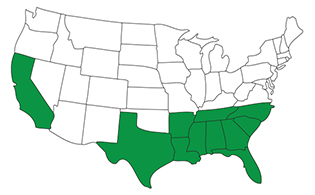
Southern Chinch Bug
Blissus insularis
The Southern Chinch Bug is a unique lawn-damaging insect that changes colors, sizes and marking throughout each nymph stage. Also known as Blissus insularis, this lawn pest is typically found in the southeastern part of the United States attacking St. Augustinegrass, but is also occasionally found in Zoysiagrass, Bahiagrass, Bermudagrass and Centipedegrass.
Identify

Crown & Thatch
An adult Southern Chinch Bug is gray to black in color and covered with fine hairs. This lawn pest has white wings with an identifying black spot located in the front middle edge, and its legs are often burnt orange in color. This lawn-damaging insect can also sometimes have short wings that end halfway down the abdomen. The Southern Chinch Bug is nearly identical in appearance to the Hairy Chinch Bug—the region you find each lawn pest living (i.e., the area of adaptation) is the easiest way to identify each one. The Southern Chinch Bug also undergoes five nymphal stages, all of which result in different colors and markings, that can serve as key identifying characteristics. Many of the instar stages feature a cream-colored band around the abdomen. Signs of Southern Chinch Bug damage in lawns appear as wilted, yellow-brown patches of grass that may coalesce if there is a severe infestation. Symptoms are first seen in stressed grass along sidewalks or driveways, especially during hot, dry weather. Actual grass damage from these lawn-damaging insects is a result of the loss of sap inside the plant as well as the toxins released by the pest that disrupt the vascular system. Drought stress can often mask the damage caused by this lawn insect.
Life Cycle
The Southern Chinch Bug primarily overwinters in its adult form; however, nymphs may survive in warmer parts of the southern states. Females deposit their eggs in between the leaf sheath and stem, and the newly emerged nymphs begin feeding under leaf sheaths. After overwintering, the first two generations of this lawn pest are fairly well-defined.

Control
There are two methods for controlling Southern Chinch Bugs that TruGreen® recommends: 1. Use professionally applied pest control designed to prevent excess lawn pest populations, which can cause damage to your lawn 2. Kill insects, grubs and other lawn pests before they have a chance to damage your lawn Proper mowing and watering techniques can also help foster a healthy lawn that's more tolerant to lawn pest attacks—plus you'll get a lawn you'll want to live on in the process.




Facebook
X
Youtube
Copy Link
Email